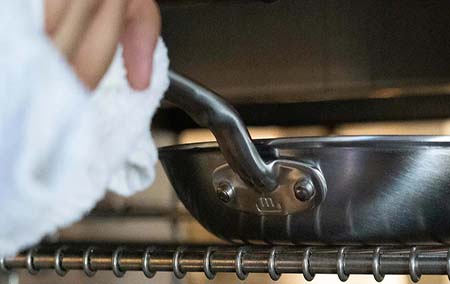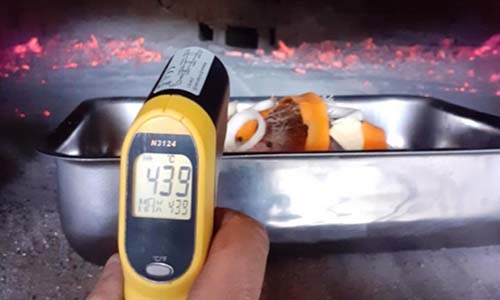When it pertains to the process of oven cooking, it is necessary to acknowledge that not all cookware possesses equal qualities. There has been a lingering curiosity among individuals regarding the safety of utilizing their reliable stainless steel pots and pans for oven purposes. In this comprehensive guide, we shall delve into the realm of stainless steel cookware and meticulously examine its compatibility with the oven in order to provide a definitive answer to the inquiry: can stainless steel be used in the oven?
Understanding Stainless Steel Cookware

Before we address its oven-worthiness, let’s take a closer look at stainless steel as a cooking material. Stainless steel has earned its place as a kitchen staple for several compelling reasons:
- Durability: To keep your stainless steel cookware looking shiny, it is advisable to periodically polish it using a stainless steel cleaner or a combination of white vinegar and water. This will assist in eliminating stains and bringing back the cookware’s lustrous appearance.
- Flavor Preservation: Unlike some other materials, stainless steel won’t react with acidic or alkaline foods. This means your sauces, soups, and dishes will retain their natural flavors without any unwanted metallic tastes.
- Easy Maintenance: Stainless steel’s smooth, non-porous surface is exceptionally easy to clean. It resists sticking, which simplifies cooking and cleanup.
- Sleek Appearance: Stainless steel cookware boasts a timeless, modern look that can enhance any kitchen decor.
- Versatility: Stainless steel’s versatility is a significant asset. It’s equally at home on the stovetop and in the oven, making it an excellent choice for a wide range of cooking techniques.
Safe Oven Temperatures for Stainless Steel

The temperature limits are the main factor determining the safety of stainless steel cookware in the oven. The majority of stainless steel cookware can be safely used in the oven at temperatures of up to 500F (260C) or potentially higher, depending on the particular grade of stainless steel employed. This excellent heat resistance is one of the reasons why stainless steel is highly favored by both professional chefs and home cooks.
However, it’s essential to emphasize that the exact safe temperature may vary depending on the specific make and model of your cookware. Therefore, it’s crucial to consult the manufacturer’s guidelines for your particular set of stainless steel cookware. These guidelines will furnish you with precise details pertaining to the utmost oven temperature that your cookware can safely withstand.. Adhering to these guidelines ensures both the longevity of your cookware and your safety in the kitchen.
Advantages of Stainless Steel in the Oven
EUsing stainless steel cookware in the oven provides a multitude of culinary opportunities, and it offers several remarkable benefits.
- Versatility: Stainless steel cookware offers great flexibility when it comes to cooking in the oven. It can be used for various purposes such as baking bread, roasting vegetables, broiling meats, making casseroles, and many other dishes.
- Even Heating: One of stainless steel’s standout qualities is its ability to distribute heat evenly across the cooking surface. This even heating ensures consistent results and perfectly browned dishes, which is especially crucial for achieving that coveted golden crust.
- Durability Under High Heat: Stainless steel cookware is built to endure high oven temperatures without warping or degrading. Whether you’re searing a steak at high heat or slow-roasting a Sunday roast, your stainless steel cookware can handle the heat with ease.
- Easy Maintenance: Stainless steel’s smooth surface is not only a breeze to clean but also resists staining and sticking. This ease of maintenance makes it a favorite for oven-to-table dishes and busy kitchens where quick cleanups are essential.
Now that we have examined the characteristics of cookware made from stainless steel, the appropriate temperatures for oven use, and the advantages it offers for your cooking pursuits, you are more prepared to utilize this adaptable material with assurance for all your baking requirements.
Identifying Oven-Safe Stainless Steel
Determining whether your stainless steel cookware is oven-safe is a straightforward process. Here’s what you should do:
- Check for Labels: Many manufacturers label their stainless steel cookware with its maximum safe oven temperature. This label is often found on the cookware’s handle or base. Look for phrases like “oven-safe” or specific temperature limits, such as “up to 500°F (260°C).” This information will give you confidence in using your cookware in the oven.
- Examine Product Manuals: If you can’t locate a label or need more detailed information, consult the product’s manual or instructions. Manufacturers often provide oven safety guidelines and temperature limits in these documents. You can typically find product manuals on the manufacturer’s website or request a copy if you no longer have the original.
- Contact the Manufacturer: When in doubt, reach out to the cookware manufacturer. They can provide specific details about the oven safety of your particular product, ensuring you have accurate and up-to-date information.
By adhering to these instructions, you will be able to determine with absolute certainty if your stainless steel kitchenware is suitable for oven applications and the highest temperature it can endure.
Dispelling Common Myths

There are a few myths and misconceptions about using stainless steel in the oven. It’s important to set the record straight:
Myth: Stainless Steel Cookware Is Entirely Non-Stick
Reality: While stainless steel is known for its resistance to sticking, it is not entirely non-stick like Teflon-coated cookware. Proper preheating and using adequate oil or fats are essential to prevent sticking when cooking with stainless steel. However, with the right techniques, you can achieve a relatively non-stick cooking surface.
Myth: Stainless Steel Cookware Is Too Heavy
Reality: While stainless steel cookware can be substantial, its weight varies depending on the thickness of the metal. Some stainless steel cookware is designed with a thinner base and is more lightweight, making it easier to handle. Heavier stainless steel cookware often provides better heat retention and distribution, which can be advantageous for certain cooking techniques.
Myth: Stainless Steel Cookware Cannot Handle High Heat
Reality: High-grade cookware made of stainless steel is specifically engineered to withstand high temperatures without warping or deteriorating. It is suitable for searing, browning, and other cooking techniques that involve high heat. However, it is important to consult the manufacturer’s instructions to determine the recommended temperature limits for your specific cookware.
Myth: Stainless Steel Cookware Cannot Go in the Dishwasher
Reality: While it is advised to practice hand washing in order to uphold the visual appeal of the cookware, numerous stainless steel pots and pans can be safely cleaned in a dishwasher. Nevertheless, excessive usage of the dishwasher may gradually diminish the cookware’s radiance. Opting for hand washing with a mild soap and warm water presents a more delicate alternative.
Myth: Stainless Steel Cookware Cannot Develop Patina or Seasoning
Reality: While stainless steel does not form a seasoning like cast iron, it has the potential to develop a patina over time, particularly with frequent use. This patina has the ability to enhance its non-stick qualities and enhance its overall performance.
Myth: All Stainless Steel Cookware Is the Same
Reality: Not all stainless steel cookware is created equal. Different grades of stainless steel are used in cookware, and the quality can vary. High-quality stainless steel cookware is typically made with 18/10 stainless steel (18% chromium and 10% nickel), which offers excellent durability and resistance to corrosion.
By debunking these misconceptions and acquiring a deeper comprehension of the abilities and qualities of stainless steel cookware, you can fully utilize this versatile kitchen utensil and savor a diverse array of culinary adventures.
Caring for Your Oven-Safe Stainless Steel
Proper attention and upkeep are imperative in order to guarantee the ongoing optimal functionality of your stainless steel cookware
- Cool Before Cleaning: After using your cookware in the oven, allow it to cool to a safe temperature before cleaning. Plunging hot stainless steel into cold water can lead to warping or damage.
- Use Gentle Cleaners: When cleaning, opt for mild, soapy water and a soft cloth or sponge. Avoid harsh scrubbers or abrasive cleaners that can scratch the surface. For stubborn stains or burnt-on residue, you can create a paste using baking soda and water to gently scrub the affected area.
- Occasional Polishing: To maintain the sleek appearance of your stainless steel cookware, it is advisable to regularly polish it using a designated stainless steel cleaner or a mixture of white vinegar and water. This routine helps remove stains and restore the cookware’s shining quality.
Exploring Oven-Safe Alternatives
While stainless steel is an excellent choice for oven cooking, there are other oven-safe cookware materials to consider based on your cooking preferences and needs:
- Cast Iron: Known for its excellent heat retention and even heating, cast iron is perfect for baking, roasting, and making hearty dishes like cornbread and casseroles.
- Glass: Glass bakeware is ideal for dishes that require transparency, such as lasagnas and cobblers. It’s also non-reactive and easy to clean.
- Ceramic: Ceramic dishes offer even heating and are fantastic for casseroles, gratins, and desserts. They come in a variety of colors and designs, adding a touch of style to your table.
- Non-Stick Options: Certain non-stick cookware is oven-safe, making it suitable for baking dishes like frittatas and quiches. Be sure to check the manufacturer’s guidelines for temperature limits.
Further Reading and Resources - For more in-depth information on cookware, oven cooking tips, and delicious recipes, explore our recommended resources and expert advice to enhance your culinary skills and kitchen experience.